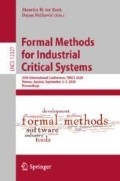Abstract
Real-time systems are subject to strong timing requirements, and thus rely on worst-case timing analyses to safely address them. Undesired timing phenomena, called timing anomalies, threaten the soundness of timing analyses. In this regard, we consider the following inauspicious partnership - a compositional timing analysis and amplification timing anomalies. Precisely, we investigate how the industrial, superscalar TriCore architecture is amenable for compositional timing analyses via a formal evaluation of amplification timing anomalies. We adapt and extend a specialized abstraction, called canonical pipeline model, to quantify the amplification effects in a model of a dual-pipelined TriCore, its asynchronous store buffer, data dependencies, and structural hazards. We use model checking to efficiently detect amplification timing anomalies and report the associated complexity results.
Access this chapter
Tax calculation will be finalised at checkout
Purchases are for personal use only
References
Asavoae, M., Hedia, B.B., Jan, M.: Formal executable models for automatic detection of timing anomalies. In: 18th International Workshop on Worst-Case Execution Time Analysis (WCET), Barcelona, Spain, pp. 2:1–2:13 (2018)
Ballabriga, C., Cassé, H., Rochange, C., Sainrat, P.: OTAWA: an open toolbox for adaptive WCET analysis. In: Min, S.L., Pettit, R., Puschner, P., Ungerer, T. (eds.) SEUS 2010. LNCS, vol. 6399, pp. 35–46. Springer, Heidelberg (2010). https://doi.org/10.1007/978-3-642-16256-5_6
Binder, B., Jan, M.: UCLID5 model for tricore (2020). https://github.com/t-crest/patmos-sail/tree/master/uclid/tricore
de Dinechin, B.D., van Amstel, D., Poulhiès, M., Lager, G.: Time-critical computing on a single-chip massively parallel processor. In: Proceedings of the Conference on Design, Automation & Test in Europe (DATE 2014), pp. 97:1–97:6 (2014)
Eisinger, J., Polian, I., Becker, B., Metzner, A., Thesing, S., Wilhelm, R.: Automatic identification of timing anomalies for cycle-accurate worst-case execution time analysis. In: Proceedings of the Workshop on Design & Diagnostics of Electronic Circuits & Systems (DDECS), Prague, Czech Republic, pp. 15–20, April 2006
Hahn, S., Reineke, J.: Design and analysis of SIC: a provably timing-predictable pipelined processor core. In: 2018 IEEE Real-Time Systems Symposium (RTSS), pp. 469–481, December 2018
Hahn, S., Jacobs, M., Reineke, J.: Enabling compositionality for multicore timing analysis. In: Plantec, A., Singhoff, F., Faucou, S., Pinho, L.M. (eds.) Proceedings of the 24th International Conference on Real-Time Networks and Systems, RTNS 2016, Brest, France, 19–21 October 2016, pp. 299–308. ACM (2016)
Hahn, S., Reineke, J., Wilhelm, R.: Towards compositionality in execution time analysis: definition and challenges. SIGBED Rev. 12(1), 28–36 (2015)
Infineon Technologies AG: TriCore 1 Pipeline Behaviour and Instruction Execution Timing, June 2004
Infineon Technologies AG: AURIX TC21x/TC22x/TC23x Family 32-Bit Single-Chip Microcontroller User’s Manual, December 2014
Jan, M., Asavoae, M., Schoeberl, M., Lee, E.: Formal semantics of predictable pipelines: a comparative study. In: Proceedings of the 25th Asia and South Pacific Design Automation Conference, United States. IEEE (2020)
Liu, I., Reineke, J., Lee, E.A.: A PRET architecture supporting concurrent programs with composable timing properties. In: 44th Asilomar Conference on Signals, Systems, and Computers, November 2010
Lundqvist, T., Stenstrom, P.: Timing anomalies in dynamically scheduled microprocessors, pp. 12–21, December 1999
Nguyen, V.A., Jenn, E., Serwe, W., Lang, F., Mateescu, R.: Using model checking to identify timing interferences on multicore processors. In: ERTS 2020–10th European Congress on Embedded Real Time Software and Systems, Toulouse, France, pp. 1–10 (2020)
Reineke, J., et al.: A definition and classification of timing anomalies. In: 6th International Workshop on Worst-Case Execution Time (WCET) Analysis, Dresden, Germany, July 2006
Schoeberl, M., et al.: T-CREST: time-predictable multi-core architecture for embedded systems. J. Syst. Arch. Embed. Syst. Des. 61(9), 449–471 (2015)
Seshia, S., Subramanyan, P.: UCLID 5: integrating modeling, verification, synthesis and learning, pp. 1–10, December 2018
Sun, W.T., Jenn, E., Cassé, H.: Build your own static WCET analyser: the case of the automotive processor AURIX TC275. In: 10th European Congress on Embedded Real Time Software and Systems (ERTS 2020), January 2020
Ungerer, T., et al.: Merasa: multicore execution of hard real-time applications supporting analyzability. IEEE Micro 30(5), 66–75 (2010)
Wenzel, I., Kirner, R., Puschner, P.P., Rieder, B.: Principles of timing anomalies in superscalar processors. In: International Conference on Quality Software (QSIC 2005), Melbourne, Australia, pp. 295–306, September 2005
Wilhelm, S., Wachter, B.: Towards symbolic state traversal for efficient WCET analysis of abstract pipeline and cache models. In: 7th International Workshop on Worst-Case Execution Time (WCET) Analysis, Pisa, Italy, 3 July 2007 (2007)
Author information
Authors and Affiliations
Corresponding author
Editor information
Editors and Affiliations
Rights and permissions
Copyright information
© 2020 Springer Nature Switzerland AG
About this paper
Cite this paper
Binder, B., Asavoae, M., Brandner, F., Ben Hedia, B., Jan, M. (2020). Scalable Detection of Amplification Timing Anomalies for the Superscalar TriCore Architecture. In: ter Beek, M.H., Ničković, D. (eds) Formal Methods for Industrial Critical Systems. FMICS 2020. Lecture Notes in Computer Science(), vol 12327. Springer, Cham. https://doi.org/10.1007/978-3-030-58298-2_6
Download citation
DOI: https://doi.org/10.1007/978-3-030-58298-2_6
Published:
Publisher Name: Springer, Cham
Print ISBN: 978-3-030-58297-5
Online ISBN: 978-3-030-58298-2
eBook Packages: Computer ScienceComputer Science (R0)

